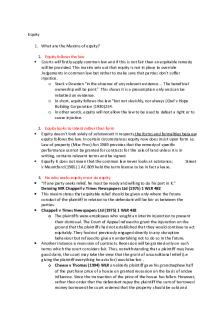The Delphic Maxims - By Aeschylus PDF

| Title | The Delphic Maxims - By Aeschylus |
|---|---|
| Author | Rebecca D'Ambrosio |
| Course | Academic English |
| Institution | University of Exeter |
| Pages | 2 |
| File Size | 41.2 KB |
| File Type | |
| Total Downloads | 38 |
| Total Views | 141 |
Summary
By Aeschylus...
Description
The Delphic maxims are a set of 147 maxims inscribed on the Temple of Apollo at Delphi. Originally, they were said to have been given by the Greek god Apollo's Oracle at Delphi, Pythia, and therefore were attributed to Apollo.[1] The 3rd century doxographer Diogenes Laertius attributed them to the Seven Sages of Greece[2] as did the 5th century scholar Stobaeus.[3] Contemporary scholars, however, hold that their original authorship is uncertain and that 'most likely they were popular proverbs, which tended later to be attributed to particular sages.'[4] Roman educator Quintilian argued that students should copy those aphorisms often to improve their moral core.[5] Perhaps the most famous of these maxims is 'know thyself,' which was carved above the entrance to the Temple of Apollo at Delphi. The specific order and wording of each maxim varies among different versions (and translations) of the text. An adage (/ˈ ædɪ dʒ /; Latin: adagium) is a concise, memorable, and usually philosophical aphorism that communicates an important truth derived from experience, custom, or both, and that many people consider true and credible because of its longeval tradition, i.e. being handed down generation to generation, or memetic replication.
An adage sometimes implicates a failure to plan, such as "do not count your chickens before they hatch" and "do not burn your bridges".[citation needed] Adages may be interesting observations, ethical rules, or skeptical comments on life in general.
Some adages are products of folk wisdom that attempt to summarize a basic truth; these are generally known as "proverbs" or "bywords". An adage that describes a general moral rule is a "maxim". A pithy expression that has not necessarily gained credibility by tradition, but is distinguished by especial depth or excellent style is denominated an "aphorism", while one distinguished by wit or irony is often denominated an "epigram".
Through overuse, an adage may become denominated a "cliché", "truism", or "old saw". Adages originating in modernity are often given proper names and denominated "laws", in imitation of the nomenclature of physical laws, or "principles".[citation needed] Some adages, such as Murphy's Law, are first formulated informally and given proper names later, while others, such as the Peter Principle, are given proper names when formulated; it might be argued that the latter do not represent true adages, but the two are often difficult to distinguish.[citation needed]
Adages that were collected and used by ancient writers inspired Dutch humanist Desiderius Erasmus Roterodamus to publish his own collection. He revised his moderate volume of 800 adages multiple times until the final edition of Adagia published in 1536 included over 4,000.[1] There have been many such collections since, usually in vernacular languages.[citation needed]
Adages formulated in popular works of fiction often find their way into popular culture, especially when a subculture devoted to the work or its genre exists, as in the case of novels of science fiction. [citation needed] Many professions and subcultures create their own adages, which are cognizable as a kind of jargon; such adages may find their way into popular use, sometimes being altered in the
process.[citation needed] Online communities, such as those that develop in Internet forums or Usenet newsgroups, often generate their own adages...
Similar Free PDFs

Legal Maxims and Phrases
- 15 Pages

ILS Equitable Maxims ho 15
- 4 Pages

121 Important Legal Maxims
- 11 Pages

Topic 1- Legal Maxims
- 7 Pages

Legal-Maxims - article
- 29 Pages

Macho Alfa Supremo-Aeschylus Subs
- 14 Pages

Legal Maxims - Lecture notes 54
- 10 Pages

Maxims of Equity Equity Law
- 5 Pages

Legal Maxims and its meaning
- 31 Pages

Benefits OF Maxims OF Teaching
- 5 Pages
Popular Institutions
- Tinajero National High School - Annex
- Politeknik Caltex Riau
- Yokohama City University
- SGT University
- University of Al-Qadisiyah
- Divine Word College of Vigan
- Techniek College Rotterdam
- Universidade de Santiago
- Universiti Teknologi MARA Cawangan Johor Kampus Pasir Gudang
- Poltekkes Kemenkes Yogyakarta
- Baguio City National High School
- Colegio san marcos
- preparatoria uno
- Centro de Bachillerato Tecnológico Industrial y de Servicios No. 107
- Dalian Maritime University
- Quang Trung Secondary School
- Colegio Tecnológico en Informática
- Corporación Regional de Educación Superior
- Grupo CEDVA
- Dar Al Uloom University
- Centro de Estudios Preuniversitarios de la Universidad Nacional de Ingeniería
- 上智大学
- Aakash International School, Nuna Majara
- San Felipe Neri Catholic School
- Kang Chiao International School - New Taipei City
- Misamis Occidental National High School
- Institución Educativa Escuela Normal Juan Ladrilleros
- Kolehiyo ng Pantukan
- Batanes State College
- Instituto Continental
- Sekolah Menengah Kejuruan Kesehatan Kaltara (Tarakan)
- Colegio de La Inmaculada Concepcion - Cebu





